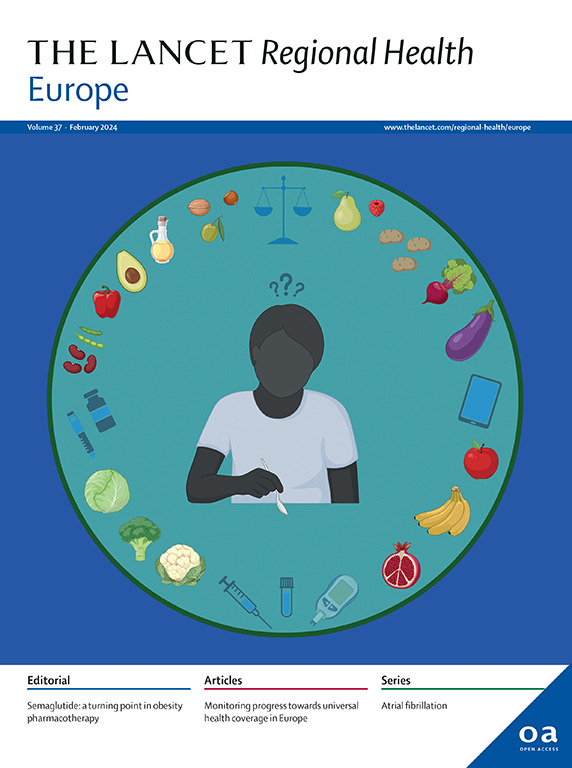Eligibility criteria for lung cancer screening in France: a modelling study
IF 13.6
Q1 HEALTH CARE SCIENCES & SERVICES
引用次数: 0
Abstract
Background
We estimated the potential impact of different eligibility criteria for lung cancer screening in France, to inform a planned national pilot program.
Methods
We simulated the French population by integrating national population estimates and smoking prevalence with lung cancer risk factors from the CONSTANCES cohort. We predicted lung cancer cases and deaths using the Lung Cancer [Death] Risk Assessment Tool for individuals with a smoking history. We evaluated four screening eligibility strategies: the US Preventive Services Task Force criteria (USPSTF) 2013, USPSTF-2021, NELSON, and a risk-based strategy (PLCOm2012 model).
Findings
We simulated 14,860,000 individuals with a smoking history aged 50–80 years in France. We estimated 11,000–14,000 preventable lung cancer deaths over 5 years by screening 2.4–4.0 million individuals, depending on eligibility criteria. When screening the same number of individuals, we estimated the risk-based strategy would identify an additional 12–22% preventable lung cancer deaths compared with categorical criteria. Individuals selected by risk-based criteria were typically 5–7 years older, with 4–6 years shorter life expectancy, but categorical criteria selected many individuals with low anticipated screening benefit (33% among USPSTF-2021-eligible). Restricting to individuals aged 50–74, 55–80, and 55–74 years gave smaller differences between categorical and risk-based criteria in age (2–6 years difference), life expectancy (2–5 years difference), and preventable lung cancer deaths (6–17% difference).
Interpretation
Screening high-risk individuals for lung cancer might prevent over 10,000 lung cancer deaths in France over 5 years, with potentially higher efficiency for risk-based eligibility compared with categorical criteria.
Funding
l’Institut National du Cancer.
背景我们估算了法国不同肺癌筛查资格标准的潜在影响,为计划中的全国试点项目提供参考。方法我们通过整合全国人口估计值、吸烟率和CONSTANCES队列中的肺癌风险因素,对法国人口进行了模拟。我们使用肺癌[死亡]风险评估工具对有吸烟史的人群进行了肺癌病例和死亡预测。我们评估了四种筛查资格策略:美国预防服务工作组 2013 年标准(USPSTF)、USPSTF-2021、NELSON 和基于风险的策略(PLCOm2012 模型)。根据筛查资格标准的不同,我们估计通过对 240-400 万人进行筛查,5 年内可预防的肺癌死亡人数为 11000-14000 人。在筛查相同数量的人时,我们估计与分类标准相比,基于风险的策略可多发现 12%-22% 的可预防肺癌死亡病例。通过基于风险的标准筛选出的个体通常年龄大 5-7 岁,预期寿命短 4-6 年,但分类标准筛选出的许多个体预期筛查获益较低(在 USPSTF-2021 符合条件的个体中占 33%)。将年龄限制在50-74岁、55-80岁和55-74岁之间,分类标准和基于风险的标准在年龄(相差2-6岁)、预期寿命(相差2-5岁)和可预防的肺癌死亡人数(相差6-17%)方面的差异较小。
本文章由计算机程序翻译,如有差异,请以英文原文为准。
求助全文
约1分钟内获得全文
求助全文
来源期刊

Lancet Regional Health-Europe
Multiple-
CiteScore
19.90
自引率
1.40%
发文量
260
审稿时长
9 weeks
期刊介绍:
The Lancet Regional Health – Europe, a gold open access journal, is part of The Lancet's global effort to promote healthcare quality and accessibility worldwide. It focuses on advancing clinical practice and health policy in the European region to enhance health outcomes. The journal publishes high-quality original research advocating changes in clinical practice and health policy. It also includes reviews, commentaries, and opinion pieces on regional health topics, such as infection and disease prevention, healthy aging, and reducing health disparities.
 求助内容:
求助内容: 应助结果提醒方式:
应助结果提醒方式:


